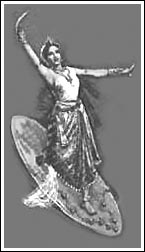
HOME | MOVIES | FEEDBACK |

Dinesh Raheja
With the boldly-individualistic Jhanak Jhanak Payal Baaje (1955), V Shantaram thumped his chest to affirm that he was proud of the beauty and artistic richness of Indian classical dance, manifest in its myriad forms like Kathak, Bharat Natyam, Manipuri.
Jhanak... was a major moneyspinner that ran at one theatre for two years.
Creating a song-and-dance extravaganza, Shantaram made Jhanak... one of Hindi cinema's primary classics of the heart and the eye.
Probably to underline the fact that Indian dance is more colourful than a box of paints, he became one of the first Indian filmmakers to choose the technicolour format to tell his story. Not surprising, considering he had also directed Sairandhri, an early experiment in colour, as far back as 1933!
After the imaginatively shot titles (the credits appear on rangolis), Jhanak... opens with an aging proponent of dance as high art --- respectfully called Guruji (Keshavrao Date) --- tearing up posters of a dancing girl and hurling abuses. He is enraged because of the blatant selling-out by his one-time protégée Roopkala who now dances for money. His anger is fuelled by the performance of yet another dancing girl, Neela (Sandhya). After reprimanding a dazed Neela, the guru makes his son and disciple Girdhar (Gopi Kishen) dance at her home and impress upon her the loftiness of classical dancing.
A converted Neela fervently asks the guru to accept her as his disciple. He demands total allegiance to dancing ('Mujhe tumhari sampati nahin, tumhari mehnat chahiye') and she readily takes a vow of single-minded dedication.
The guru toils hard to prepare Neela as Girdhar's dance partner for a prestigious competition where he wants Girdhar to win the coveted title of Bharat Natarajan.
Young love, however, is not to be denied. While Neela's feet learn to move rhythmically to the guru's taal, her heart begins to pulsate for Girdhar. Her wide-eyed admiration is instantly reciprocated by the equally-smitten Girdhar. But Mani Babu (Madan Puri), who has financed Neela's passion for dancing because he wants to marry her, is incensed; he promptly squeals to the guru.
The infuriated guru, already upset with Neela for encouraging Girdhar to join him in a Western dance performance earlier, accuses Neela of derailing Girdhar from his goal. Neela's pleas of 'pavitra prem' go unheeded. In keeping with the demands of the guru-shishya tradition, Neela decides to keep her guru happy and abandons Girdhar, presumably for her patron, Mani Babu. In a series of dramatic twists --- the least engaging part of this otherwise fluid film --- she incurs Girdhar's wrath, leaves Mani Babu in the lurch and makes a futile attempt to end her life by jumping into the river. When all else fails, she embraces the life of a mendicant.
However, Girdhar and Neela's destiny seems intractably intertwined. When Girdhar reaches the final of the Bharat Natarajan contest, his partner suddenly abandons him. But the dismayed guru and Girdhar are stunned as a pair of feet don the ghungroos. Despite burning with fever, Neela has arrived to partner her lover. An angry Girdhar is reluctant to perform with the 'unfaithful' Neela but the guru orders him otherwise. A fervour-filled tandav and a tame truce follows.
Sandhya never bettered her performance in Jhanak Jhanak Payal Baaje. For one, the role of a keen learner and a dedicated disciple fitted her like a glove. In later films, she showed a marked predisposition for rolling her eyes and shaking her head like a spring doll. These quintessentially Sandhya mannerisms, which became second skin to her as the years and the reels rolled by, made only an occasional appearance in this early performance, and so don't distract from her endearing naivette.
Gopi Kishen struggles with his lines and seems raring to break into dance mid-sentence (and does so too on quite a few occasions). But as a choreographer and dancer he holds you spellbound.
The dances make several allusions to mythology, interweaving them intricately into the script. The romantic portion between Neela and Girdhar draws inspiration from the Krishna-Radha romance, the blossoming of their love finds its fount in the Bhil dance, while seductress Menaka's bid to seduce sage Vishwamitra provides a perfect parallel for Neela distracting Girdhar from his chosen path.
In the climax, Girdhar's rage at Neela's betrayal is projected via Shiva's famous tandav dance. Gopi Krishna visibly revels in the tandav number, hitting the screen like a tightly-wound up top which is finally unleashed. Not just dance-literate viewers but even the hoi polloi are sure to get drawn in by the magnetism of this blend of energy, undiluted anger and immense grace. It's sheer poetry in motion.
Art director Kanu Desai's sets are lavish but garish. Since technicolour was a major attraction, Desai probably got carried away by his desire to present the entire gamut of colours. Also, the abrupt shift from outdoor locales to sets with painted backdrops, is an avoidable distraction.
The comic track concerning the nok jhok between Neela's domestics, Ballu and Bindiya (Bhagwan-Manorama) unnecessarily strains the viewer's patience. K Date as the guru --- benign one moment, belligerent the next -- elevates the dramatic portions.
Despite being a dance musical boasting of two non-stars, the film was a landmark hit. There couldn't have been a more befitting testimony of Shantaram's foresight nor a better reward for his spirit of adventure.
Sidelights:
Music:
You might also want to read:
|
|||||||||
© 1996 - 2002 rediff.com India Limited. All Rights Reserved. |
||||||||||